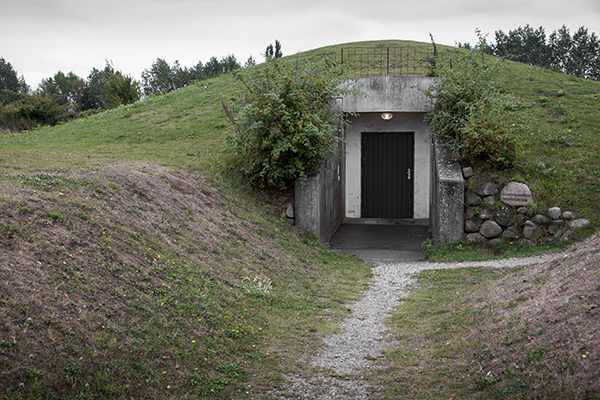
"Asmund was buried in Asmund's Grave in a ship with his slave [thrall] beside him. Someone who walked past the mound heard this verse being sung inside the mound: 'On board my ship in this stony mound, no crew here crowding around me; far better solitude than feeble support. A fine sailor I was once that won't be forgotten.' After that the mound was opened up and the slave taken from the ship."
Landnámabók ("Book of Settlements"), LXXII
Sometime during the first quarter of the tenth century, perhaps about AD 900, a Viking longship was dragged three-hundred feet uphill from a nearby fjord, laid in a trench just below ground level (its stems still exposed), covered with planks, and buried under a barrow of earth on the periphery of an existing cemetery. There it rested for more than a thousand years, until discovered in 1935 by an amateur archaeologist. The skeletons of eleven small Icelandic horses and three or four dogs were found—as well as an elaborate gilt-bronze piece that had joined the dog leash; three complete bridles, bits and stirrups; a silver whip handle; a shield boss, small axe, and bundle of arrowheads; the remnants of a gaming board; and silver-and-gold threads from richly embroidered fabric. A solid silver belt buckle also had been left behind, but the sword which it once held was missing—as were any remains of the chieftain who once had possessed these goods.
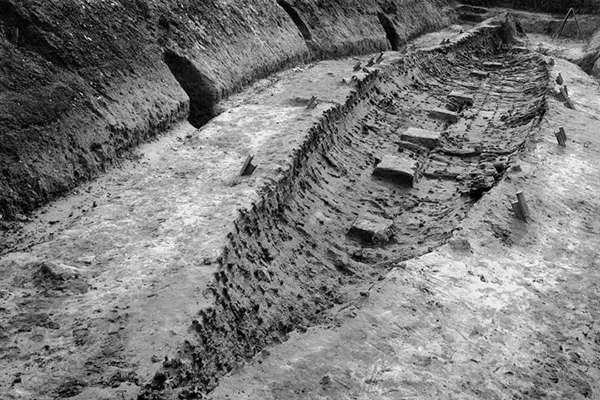
Only the imprint of the ship remained, its oak hull having almost completely rotted away, leaving behind just the iron rivets and spikes that had secured its planks. They outline a slender ship about seventy-one feet long and almost ten feet wide amidships, with a flat bottom, low freeboard, and shallow draft. Measuring from the keel to the gunwale (the upper-most edge of the ship), its height was only about three feet, half of which was the ship's draft. One can just discern the floor timbers and ribs that delineated the separate compartments of the ship, each providing space (about three feet) for a pair of oars. At most, there was room for sixteen pairs (pulled by thirty-two oarsmen), the same number as the Gokstad ship which, with sixteen strakes on a side, was twice as high amidships.

The reconstruction of the Ladby ship (based on other Viking-Age finds) can better be understood if presented in cross-section. Overlapping oak strakes or planks were riveted with clench-nails and caulked in between with twisted wool or cow hair dipped in pitch. The two bottom planks were secured to notched floor timbers by treenails (wooden pegs) and spiked to the third and fourth strakes. This last strake, which ran along each side at the waterline, was called the meginhufr ("strong plank") and strengthened the ship longitudinally at its point of greatest stress. Crossbeams or thwarts fitted over the ribs provided diagonal support to the frame and were secured by spikes to curved knees that themselves were attached to the strakes by treenails. Long stringers further reinforced the upper strakes where they overlapped. Over these beams, there was a deck of loose boards.
Thorvildsen believed that there were only seven strakes on a side, which made the deck so low that he assumed the crew must have sat on their sea chests or movable benches. He reasoned, too, that the shallow freeboard would have made the ship difficult to sail on the open sea, the high mast and broad sail putting it at risk of capsizing, although it would have been well suited for rowing in calm water. For these reasons, it is presumed that there was an eighth strake, which would increase the height of the freeboard and so allow for a second array of thwarts above the deck, supported by spindle-like stanchions, on which the rowers could sit. This upper-most strake (the sheer strake) also would have held the shield rail and been pierced by the oarports. It likely was fixed by spikes and not attached to knees or beams so, when worn or damaged, it could more easily be replaced.
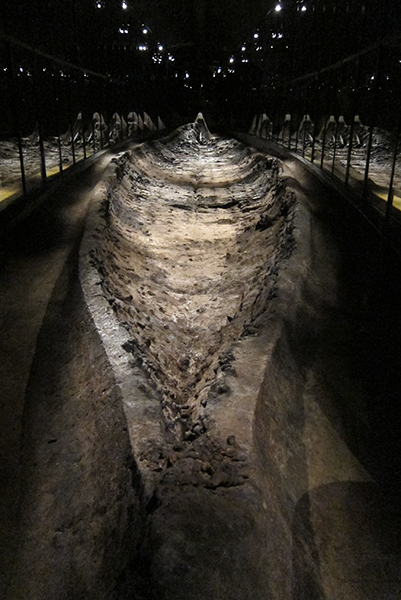
Here one can see that the sand and clay have been neatly cut away around the outline of the ship, which now is protected beneath a sod and concrete barrow in a dimly-lit glass sepulcher. It was just aft of the mast, where the chieftain had been interred, that most was disturbed when the mound was broken into. The jumble of horse skeletons at the bow no doubt discouraged any looting at that end of the ship.
There were no remains of the chieftain, nor his sword or any other personal weapons or valuable grave goods. Intriguingly, the plundering, which may have occurred only a few years after internment, could not have been done in secret by common grave robbers. Digging into the mound would have taken time and necessarily been done in public. And, even though Christianity was beginning to assert itself in a pagan Denmark, it also is unlikely that members of the settlement destroyed the body as a vestige of heathen superstition or, conversely, disinterred it for Christian burial (translatio). Another chieftain, therefore, probably was responsible for desecrating the tomb as a symbolic demonstration of his own power and a diminution of his rival's—the removal, for example, of his sword and a spur, and the needless shattering of a simple wooden bucket.
Four years later, in 1939, the impression of an older ship was discovered at Sutton Hoo on the Suffolk coast of England, only its rivets and ribs imprinted in the sand. Less than three months later, World War II began and the mound was covered again, for fear that it might be damaged by German bombs. Now only the Ladby Ship still can be seen in situ, still resting in its barrow.
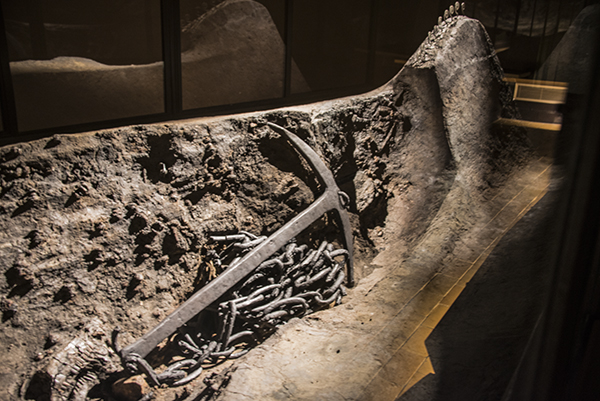
Next to a horse's jaw, an iron anchor lies in the bow of the ship, the largest one from Scandinavian antiquity, and its 36-foot-long chain the only know example. Two swivels allowed the chain to twist without kinking and a hook permitted the length to be adjusted, depending upon where the ship was anchored. Once, there had been a wooden stock fitted at right angles to the flukes so that, when the anchor came to rest, the arms would secure a hold on the bottom. The chain itself was attached to a length of rope fastened to the ship.
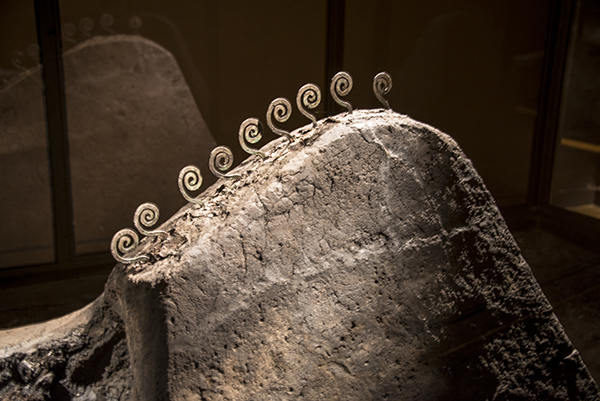
A series of small iron spirals originally were fitted to a dragon's head at the bow in imitation of its mane. At the stern, an iron band tipped with spear-head like spikes represented the scales of the dragon's tail. The wooden head itself has rotted away but likely was loosely fitted to the stem of the ship.
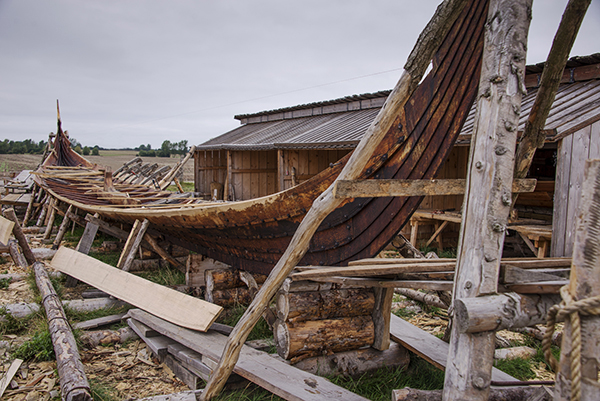
In the summer of 2011, an exact copy of the ship was begun, using traditional Viking building techniques and split oak logs from a local forest. Barely visible in its frame, the stems of the ship are stepped so that the strakes can fit neatly into place. This picture was taken in 2013, when construction had reached the meginhufr.

Three years later, the newly-christened Ladby Dragon was launched, painted in the yellow and blue that were found as traces of color at the burial site. The mast and rigging were added in 2017 and the ship now is docked at the Viking Museum, Ladby. The model also gives an impression of another, smaller Viking ship, Skuldelev 5 which it most closely resembles.
References: Ladby: A Danish Ship-Grave from the Viking Age (2001) by Anne C. Sřrensen (the definitive study); The Viking Ship of Ladby (3rd ed.) (1985) by Knud Thorvildsen; "The Ladby Ship Revisited" (1987) by Henrik Thrane, Antiquity, 61, 41-49 (prompted by the refurbishment of the site on the fiftieth anniversary of its discovery); Vikingemuseet, Ladby website; Vikingeskibsmuseet, Roskilde website; The Book of Settlements: Landnámabók (1972) translated by Hermann Pálsson and Paul Edwards.